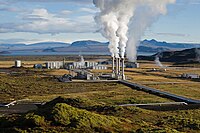
Photo from wikipedia
Abstract The deployment of geothermal energy systems can significantly contribute to climate change mitigation and play a part in the transition to a low carbon society. This study proposes a… Click to show full abstract
Abstract The deployment of geothermal energy systems can significantly contribute to climate change mitigation and play a part in the transition to a low carbon society. This study proposes a framework for identifying the shallow geothermal energy potential of new individual and district heating (DH) systems. The model accounts for thermal interference between neighbouring wells and borehole heat exchangers, where the main criteria for analysis are ground temperature, thermal conductivity, heat flow, and heat capacity. The paper presents a cost-effective area method for the identification of potential new DH areas, while considering the cost competitiveness of the heat supplied. Economic potential is determined based on the cost-effectiveness of the competing technologies, separately for urban and rural areas. The results show that although 54% of technical DH potential in Slovenia remains untapped, the future of shallow geothermal energy systems lies predominantly in individual systems, which have proven to be the most cost efficient solution on locations with favourable geological or hydro-geological conditions. Where possible, shallow geothermal energy can contribute from 2% to 25% of energy for heat production in analysed existing fossil fuel based DH systems, thus making shallow geothermal energy suitable for supplying base load power in an economical manner.
Journal Title: Energy
Year Published: 2019
Link to full text (if available)
Share on Social Media: Sign Up to like & get
recommendations!